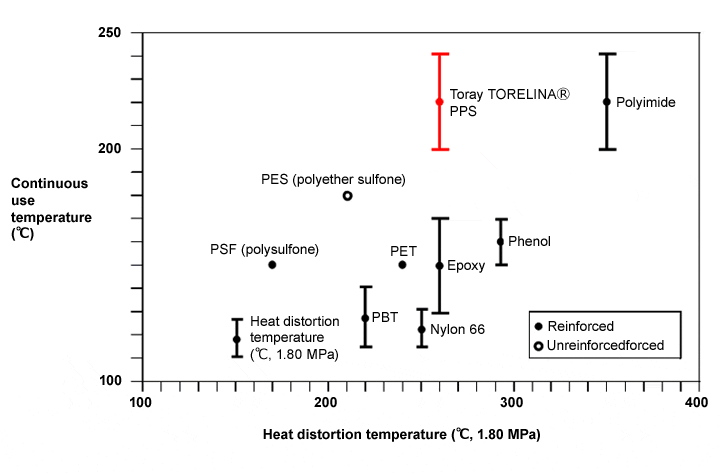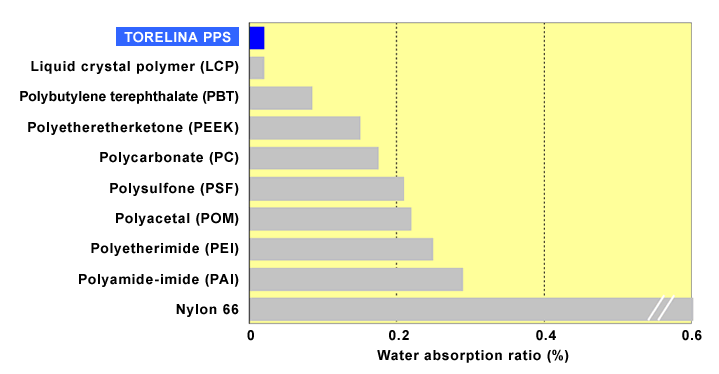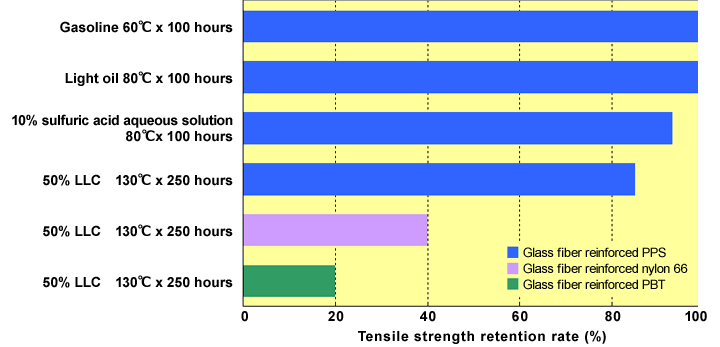- HOME
- Technical Information
- TORELINA™ PPS Resin
- Various Properties
- Basic Information
- Comparison with Other Thermoplastic Resins
Comparison with Other Thermoplastic Resins
Ⅰ. Heat Resistance
One of the most notable features of Toray PPS resin, TORELINA™, is its heat resistance. Fig. 3.1 compares the heat resistance of TORELINA™ with that of other resins. In Fig. 3.1, the horizontal axis shows the heat distortion temperature. This serves as an index of short-term heat resistance. For example, it provides a rough guide to heat resistance in reflow soldering processes in the electronic parts field. For amorphous resins, the heat distortion temperature depends on the glass transition temperature, while for reinforced crystalline resins, it depends on the melting point. Table. 3.1 lists the melting points and glass transition temperatures of various resins. Toray PPS resin, TORELINA™, has a melting point of 278℃, and a high heat distortion temperature of 260℃ or greater.

Fig. 3.1 Comparison of heat resistance of resins
Table. 3.1 Glass transition temperatures and melting points of resins
| Material | Crystallization properties |
Glass transition temperature(℃) |
Melting point(℃) |
|---|---|---|---|
| TORELINA™ PPS | Crystalline | 90 | 278 |
| Liquid crystal polymer (LCP) | - | 280 to 370 | |
| Polyetheretherketone (PEEK) | 143 | 334 | |
| Nylon 66 | 50 | 260 | |
| Polybutylene terephthalate (PBT) | 22 | 224 | |
| Polyamide-imide (PAI) | Amorphous | 280 | - |
| Polyether sulfone (PES) | 225 | - | |
| Polyetherimide (PEI) | 217 | - | |
| Polysulfone (PSF) | 190 | - | |
| Polycarbonate (PC) | 150 | - |
In Fig. 3.1, the vertical axis shows the continuous use temperature. The continuous use temperature indicates the upper temperature limit at which, after prolonged treatment (40,000 hours), the substance retains at least 50% of its strength. The continuous use temperature serves as an index of long-term heat resistance. For example, it provides a rough guide for heat resistance in the high-temperature environment of a vehicle engine bay. The continuous use temperature depends on the strength of the chemical bonds of the resin, as well as their resistance to breaking, and does not necessarily correspond to the melting point or the glass transition temperature. Toray PPS resin, TORELINA™, has a continuous use temperature of 200℃ to 240℃. There are only a limited number of resins that can offer high values of 200℃ or greater for both short- and long-term heat resistance.
Ⅱ. Water and Chemical Resistance
Toray PPS resin, TORELINA™, is also excellent in terms of its water and chemical resistance. Fig. 3.2 compares the water absorption of TORELINA™ with that of other resins.

Fig. 3.2 Comparison of water absorption of TORELINA™ and other resins
This shows that the water absorption ratio of PPS resin is very low. The reason for this is that PPS resin is highly crystalline and its chemical structure does not have a high affinity for water. Thus, a feature of PPS resin is that it is less prone to dimensional changes and strength decreases due to water absorption. It also has high resistance to hot water and solvents (Fig. 3.3).

Fig. 3.3 Chemical resistance of Toray PPS resin, TORELINA™
Ⅲ. Flame Retardance
Toray PPS resin, TORELINA™, is also excellent in terms of its flame retardance. Table. 3.2 lists the limiting oxygen indexes of other resins. The limiting oxygen index is a value that indicates the minimum oxygen concentration required for a material to burn. The higher the value, the higher the degree of flame retardance. The limiting oxygen index of glass fiber reinforced PPS is close to 47, which is high in comparison with other resins.
Table. 3.2 Flammability of other resins
| Material | Limiting oxygen index (%) |
UL flame retardance class |
|---|---|---|
| Glass fiber reinforced PPS | 47 | V-O |
| Polyetherimide (PEI) | 47 | V-O |
| Polyamide-imide (PAI) | 43 | V-O |
| Glass fiber reinforced polyester sulfone (PES) | 41 | V-O |
| Polyetheretherketone (PEEK) | 35 | V-O |
| Polysulfone (PSF) | 30 | V-2 to V-0 |
| Glass fiber reinforced nylon 66 | 24 | H-B |
| Polybutylene terephthalate (PBT) | 21 | H-B |
| Polyacetal (POM) | 16 | H-B |